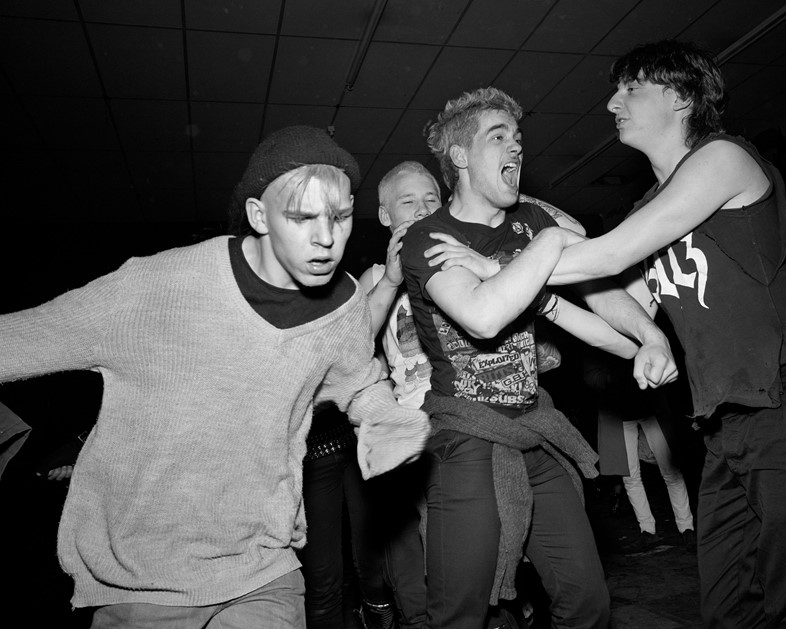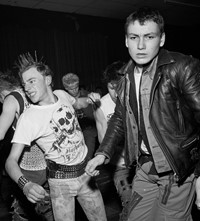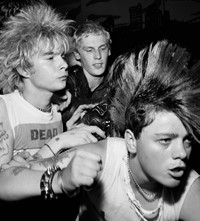Published in a new book and displayed in a now-postponed exhibition, Chris Killip’s images capture the heyday of The Station in Gateshead, Newcastle
- TextZoe Whitfield
Chris Killip heard about The Station in customary fashion, by word of mouth. Previously working in London as an assistant to the photographer Adrian Flowers, he returned to his native Isle of Man in the early 70s (he’d been inspired by an exhibition at MoMA, New York), and began photographing what he saw there, in Huddersfield and Bury St Edmunds. In 1975, his focus shifted to shooting communities in the north-east of England; he’d later close the decade as director of Newcastle upon Tyne’s Side Gallery. Many of his pictures from this time wound up in In Flagrant, his formative photo book first published in 1988 and reissued in 2015.
A dedicated performance and rehearsal venue launched by The Gateshead Music Collective and nearby community and youth workers, The Station was a source of relief for young men disgruntled by Margaret Thatcher’s policies; a space for bodies to physically collide, in-sync with the then-thriving anarcho-punk movement. “The energy was of a specific time and place,” says Killip. “In the Gateshead, Newcastle upon Tyne area, The Station was unique.” Despite amassing a distinct body of work, the photographer’s images were subsequently abandoned for several decades. Now, as he releases a new book celebrating the spirit of The Station – and with a now-postponed exhibition at the Martin Parr Foundation to follow – he speaks to Another Man.
“In 1985, I was photographing nightlife venues in and around Newcastle when someone told me about The Station in Gateshead. I visited at the first available opportunity and was amazed by the energy and feel of the place. It was totally different; run for and by the people who went there. I stopped going to other venues to photograph there on Saturday nights.
“1985 wasn’t a great time in Gateshead. It was after the miners’ strike and a lot of the punks at The Station were unemployed. This place, run as a very inclusive collective, was part of their identity in the way it affirmed their self-worth. As a venue it was unique, members of local bands, who weren’t playing that evening, were in the audience dancing.
“Nobody ever asked me where I was from or even who I was. A 39-year-old with cropped white hair who always wore a suit – the jacket had pockets stitched inside of it to hold my four by five inch slides. With a big flatbed plate camera around my neck and a hefty Norman flash – its outsized battery around my waist – I must have looked like something out of a 1950s B-movie.

“The Station was a difficult place to photograph in. The walls, ceiling and floor were black. There was no lighting and I couldn’t see to focus. I had to pre-set the focus by guessing the distance that I was going to be from whoever I photographed. It was tricky and I made a lot of mistakes but I thought that it was worth persevering with the plate camera because of the quality of the image if you got everything right. It was nerve-wracking and I used to leave there completely drained.
“In 2016, my son was rooting around in my studio when he came over to me with a box of contacts. They were prints from The Station – I had only published three images from The Station and hadn’t looked at them in over 30 years. He told me that they were really something, and I realised he was right.
“I initially made a book with an online publisher and hated how it looked – it in no way reflected the energy or feel of The Station. I realised then I needed design help and contacted designers whose work I admired, Niall Sweeney and Nigel Truswell of Pony in London. They had an intuitive grasp of what was needed and their design is now such an important part of the book. A newsprint version was published in 2018 to accompany an exhibition at the Baltic Centre for Contemporary Art in Gateshead, 200 yards from the original Station. With the Steidl book being released, it’s great to see the work reaching new people and developing its own momentum.”
The Station by Chris Killip, published by Steidl. Buy a copy here. The exhibition has been postponed, but will be at the Martin Parr Foundation in Bristol.















